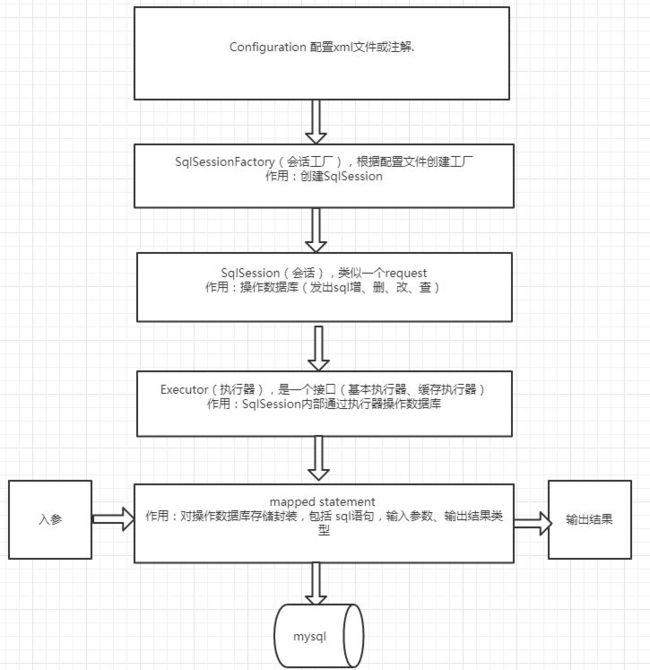mybatis执行流程_自己手写一个Mybatis框架(简化)
继上一篇手写SpringMVC之后,我最近趁热打铁,研究了一下Mybatis。MyBatis框架的核心功能其实不难,无非就是动态代理和jdbc的操作,难的是写出来可扩展,高内聚,低耦合的规范的代码。本文完成的Mybatis功能比较简单,代码还有许多需要改进的地方,大家可以结合Mybatis源码去动手完善。
一、Mybatis框架流程简介
在手写自己的Mybatis框架之前,我们先来了解一下Mybatis,它的源码中使用了大量的设计模式,阅读源码并观察设计模式在其中的应用,才能够更深入的理解源码(ref:Mybatis源码解读-设计模式总结)。我们对上图进行分析总结:
mybatis的配置文件有2类
mybatisconfig.xml,配置文件的名称不是固定的,配置了全局的参数的配置,全局只能有一个配置文件。
Mapper.xml 配置多个statemement,也就是多个sql,整个mybatis框架中可以有多个Mappe.xml配置文件。
通过mybatis配置文件得到SqlSessionFactory
通过SqlSessionFactory得到SqlSession,用SqlSession就可以操作数据了。
SqlSession通过底层的Executor(执行器),执行器有2类实现: 
基本实现
带有缓存功能的实现
MappedStatement是通过Mapper.xml中定义statement生成的对象。
参数输入执行并输出结果集,无需手动判断参数类型和参数下标位置,且自动将结果集映射为Java对象
HashMap,KV格式的数据类型
Java的基本数据类型
POJO,java的对象
二、梳理自己的Mybatis的设计思路
根据上文Mybatis流程,我简化了下,分为以下步骤:
1.读取xml文件,建立连接
从图中可以看出,MyConfiguration负责与人交互。待读取xml后,将属性和连接数据库的操作封装在MyConfiguration对象中供后面的组件调用。本文将使用dom4j来读取xml文件,它具有性能优异和非常方便使用的特点。
2.创建SqlSession,搭建Configuration和Executor之间的桥梁
我们经常在使用框架时看到Session,Session到底是什么呢?一个Session仅拥有一个对应的数据库连接。类似于一个前段请求Request,它可以直接调用exec(SQL)来执行SQL语句。从流程图中的箭头可以看出,MySqlSession的成员变量中必须得有MyExecutor和MyConfiguration去集中做调配,箭头就像是一种关联关系。我们自己的MySqlSession将有一个getMapper方法,然后使用动态代理生成对象后,就可以做数据库的操作了。
3.创建Executor,封装JDBC操作数据库
Executor是一个执行器,负责SQL语句的生成和查询缓存(缓存还没完成)的维护,也就是jdbc的代码将在这里完成,不过本文只实现了单表,有兴趣的同学可以尝试完成多表。
4.创建MapperProxy,使用动态代理生成Mapper对象
我们只是希望对指定的接口生成一个对象,使得执行它的时候能运行一句sql罢了,而接口无法直接调用方法,所以这里使用动态代理生成对象,在执行时还是回到MySqlSession中调用查询,最终由MyExecutor做JDBC查询。这样设计是为了单一职责,可扩展性更强。
三、实现自己的Mybatis
工程文件及目录:
首先,新建一个maven项目,在pom.xml中导入以下依赖:
创建我们的数据库xml配置文件:
xml version="1.0" encoding="UTF-8"?>
然后在数据库创建test库,执行如下SQL语句:
CREATE TABLE `user` (`id` varchar(64) NOT NULL,`password` varchar(255) DEFAULT NULL,`username` varchar(255) DEFAULT NULL,
PRIMARY KEY (`id`)
) ENGINE=InnoDB AUTO_INCREMENT=2 DEFAULT CHARSET=utf8;INSERT INTO `test`.`user` (`id`, `password`, `username`) VALUES ('1', '123456', 'liugh');
创建User实体类,和UserMapper接口和对应的xml文件:
package com.liugh.bean;public class User { private String id;private String username;private String password;//省略get set toString方法...
}
package com.liugh.mapper;
import com.liugh.bean.User;public interface UserMapper { public User getUserById(String id);
}"1.0" encoding="UTF-8"?>"com.liugh.mapper.UserMapper">
基本操作配置完成,接下来我们开始实现MyConfiguration:
package com.liugh.sqlSession;import java.io.InputStream;import java.sql.Connection;import java.sql.DriverManager;import java.sql.SQLException;import java.util.ArrayList;import java.util.Iterator;import java.util.List;import org.dom4j.Document;import org.dom4j.DocumentException;import org.dom4j.Element;import org.dom4j.io.SAXReader;import com.liugh.config.Function;import com.liugh.config.MapperBean;/**
* 读取与解析配置信息,并返回处理后的Environment
*/public class MyConfiguration { private static ClassLoader loader = ClassLoader.getSystemClassLoader();/**
* 读取xml信息并处理
*/public Connection build(String resource){ try {
InputStream stream = loader.getResourceAsStream(resource);
SAXReader reader = new SAXReader();
Document document = reader.read(stream);
Element root = document.getRootElement();return evalDataSource(root);
} catch (Exception e) { throw new RuntimeException("error occured while evaling xml " + resource);
}
}private Connection evalDataSource(Element node) throws ClassNotFoundException { if (!node.getName().equals("database")) { throw new RuntimeException("root should be ");
}String driverClassName = null;String url = null;String username = null;String password = null;//获取属性节点for (Object item : node.elements("property")) {
Element i = (Element) item; String value = getValue(i);String name = i.attributeValue("name");if (name == null || value == null) { throw new RuntimeException("[database]: should contain name and value");
}//赋值switch (name) { case "url" : url = value; break;case "username" : username = value; break;case "password" : password = value; break;case "driverClassName" : driverClassName = value; break; default : throw new RuntimeException("[database]: unknown name");
}
}
Class.forName(driverClassName);
Connection connection = null;try { //建立数据库链接
connection = DriverManager.getConnection(url, username, password);
} catch (SQLException e) { // TODO Auto-generated catch block
e.printStackTrace();
}return connection;
}//获取property属性的值,如果有value值,则读取 没有设置value,则读取内容private String getValue(Element node) { return node.hasContent() ? node.getText() : node.attributeValue("value");
}@SuppressWarnings("rawtypes")public MapperBean readMapper(String path){
MapperBean mapper = new MapperBean();try{
InputStream stream = loader.getResourceAsStream(path);
SAXReader reader = new SAXReader();
Document document = reader.read(stream);
Element root = document.getRootElement();
mapper.setInterfaceName(root.attributeValue("nameSpace").trim()); //把mapper节点的nameSpace值存为接口名
List
Element e = (Element) rootIter.next(); String sqltype = e.getName().trim();String funcName = e.attributeValue("id").trim();String sql = e.getText().trim();String resultType = e.attributeValue("resultType").trim();
fun.setSqltype(sqltype);
fun.setFuncName(funcName);Object newInstance=null;try {
newInstance = Class.forName(resultType).newInstance();
} catch (InstantiationException e1) {
e1.printStackTrace();
} catch (IllegalAccessException e1) {
e1.printStackTrace();
} catch (ClassNotFoundException e1) {
e1.printStackTrace();
}
fun.setResultType(newInstance);
fun.setSql(sql);
list.add(fun);
}
mapper.setList(list);
} catch (DocumentException e) {
e.printStackTrace();
}return mapper;
}
}
用面向对象的思想设计读取xml配置后:
package com.liugh.config;
import java.util.List;public class MapperBean { private String interfaceName; //接口名private List
}
Function对象包括sql的类型、方法名、sql语句、返回类型和参数类型。
package com.liugh.config;public class Function { private String sqltype; private String funcName; private String sql; private Object resultType; private String parameterType; //省略 get set方法
}
接下来实现我们的MySqlSession,首先的成员变量里得有Excutor和MyConfiguration,代码的精髓就在getMapper的方法里。
package com.liugh.sqlSession;import java.lang.reflect.Proxy;public class MySqlsession { private Excutor excutor= new MyExcutor(); private MyConfiguration myConfiguration = new MyConfiguration();public T selectOne(String statement,Object parameter){ return excutor.query(statement, parameter);
} @SuppressWarnings("unchecked")public T getMapper(Class clas){ //动态代理调用return (T)Proxy.newProxyInstance(clas.getClassLoader(),new Class[]{clas},new MyMapperProxy(myConfiguration,this));
}
}
紧接着创建Excutor和实现类:
package com.liugh.sqlSession;public interface Excutor { public T query(String statement,Object parameter);
}
MyExcutor中封装了JDBC的操作:
package com.liugh.sqlSession;import java.sql.Connection;import java.sql.PreparedStatement;import java.sql.ResultSet;import java.sql.SQLException;import com.liugh.bean.User;public class MyExcutor implements Excutor{ private MyConfiguration xmlConfiguration = new MyConfiguration();@Override public T query(String sql, Object parameter) {
Connection connection=getConnection();
ResultSet set =null;
PreparedStatement pre =null;try {
pre = connection.prepareStatement(sql); //设置参数
pre.setString(1, parameter.toString());set = pre.executeQuery();
User u=new User(); //遍历结果集while(set.next()){
u.setId(set.getString(1));
u.setUsername(set.getString(2));
u.setPassword(set.getString(3));
} return (T) u;
} catch (SQLException e) {
e.printStackTrace();
} finally{ try{ if(set!=null){ set.close();
}if(pre!=null){
pre.close();
}if(connection!=null){
connection.close();
}
}catch(Exception e2){
e2.printStackTrace();
}
} return null;
} private Connection getConnection() { try {
Connection connection =xmlConfiguration.build("config.xml");return connection;
} catch (Exception e) {
e.printStackTrace();
} return null;
}
}
MyMapperProxy代理类完成xml方法和真实方法对应,执行查询:
package com.liugh.sqlSession;import java.lang.reflect.InvocationHandler;import java.lang.reflect.Method;import java.util.List;import com.liugh.config.Function;import com.liugh.config.MapperBean;public class MyMapperProxy implements InvocationHandler{ private MySqlsession mySqlsession; private MyConfiguration myConfiguration;public MyMapperProxy(MyConfiguration myConfiguration,MySqlsession mySqlsession) { this.myConfiguration=myConfiguration; this.mySqlsession=mySqlsession;
} @Overridepublic Object invoke(Object proxy, Method method, Object[] args) throws Throwable {
MapperBean readMapper = myConfiguration.readMapper("UserMapper.xml");//是否是xml文件对应的接口if(!method.getDeclaringClass().getName().equals(readMapper.getInterfaceName())){ return null;
}
List
}
}
}return null;
}
}
到这里,就完成了自己的Mybatis框架,我们测试一下:
package com.liugh;import com.liugh.bean.User;import com.liugh.mapper.UserMapper;import com.liugh.sqlSession.MySqlsession;public class TestMybatis { public static void main(String[] args) {
MySqlsession sqlsession=new MySqlsession();
UserMapper mapper = sqlsession.getMapper(UserMapper.class);
User user = mapper.getUserById("1");
System.out.println(user);
}
}
执行结果:
查询一个不存在的用户试试:
到这里我们就大功告成了!
我是个普通的程序猿,水平有限,文章难免有错误,欢迎牺牲自己宝贵时间的读者,就本文内容直抒己见,我的目的仅仅是希望对读者有所帮助。源码地址:https://github.com/qq53182347/liugh-mybatis
扩展阅读
手写实现一个HashMap
手写一个迷你版的Tomcat
手写一个迷你版SpringMVC框架
JavaScript入门写一个表单校验功能
手写spring+springmvc+mybatis框架篇【springIOC容器】
来源:https://my.oschina.net/liughDevelop/blog/1631006
文章来源网络,版权归作者本人所有,如侵犯到原作者权益,请与我们联系删除






